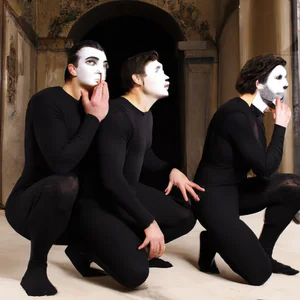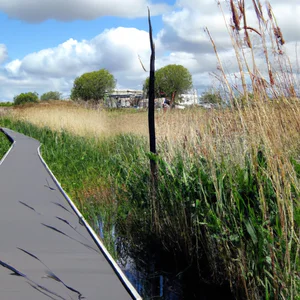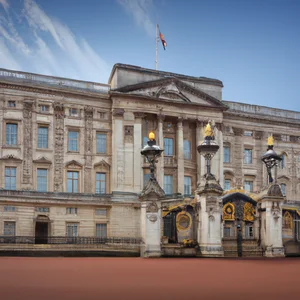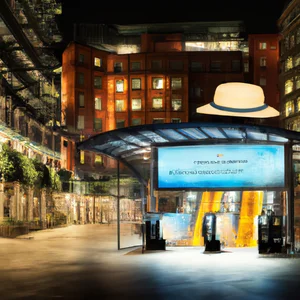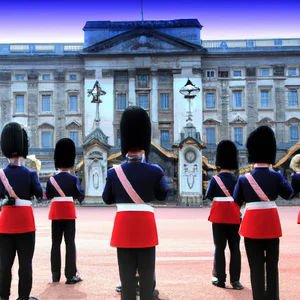Book your experience
London Aquatics Centre: Zaha Hadid's Olympic legacy
The London Aquatics Center is truly one of those facilities that will leave you speechless, whether you are a sports fan or whether you don’t understand a thing. Designed by the brilliant Zaha Hadid, who, let’s face it, was incredibly talented, this place isn’t just a pool, it’s like a floating work of art.
When I first set foot there, I think it was during one of those sunny days that make everything seem more beautiful, I felt like I had stepped into a science fiction movie. The curves and fluid shapes of the center are a bit like those waves of the sea, which embrace you and make you feel at home, even if you are far from everything.
And then, speaking of Olympic legacy, I can’t help but think about how this place marked an era. The 2012 London Olympics, wow, what an event! And Zaha, with her bold design, has created not just a place to swim, but a symbol of how architecture can transform a city.
Of course, I’m not 100% sure, but I think many, if not all, can agree that a facility like this is not just for athletes, but also for citizens. It’s a place where you can have fun, relax, and maybe even learn to swim, like I did as a kid, when I dived into the pool with friends and we had a lot of fun.
Ultimately, the London Aquatics Center is a real gem, a mix of sport and art, a bit like strawberry ice cream on a hot summer day: refreshing and unforgettable. If you haven’t visited it yet, well, I recommend you stop by, you won’t regret it!
Futuristic design: the art of Zaha Hadid
An immersive experience in art and architecture
Returning from the London Aquatics Centre, I vividly remember the feeling of being in front of one of Zaha Hadid’s most iconic works. The fluid lines and undulating profile of the building appear to dance in the sunlight, almost as if the architecture itself were a body in motion. It is an experience that goes beyond simply visiting a sports centre; it’s like entering a living work of art, where every corner invites you to explore. This experience is not only visual, but also extends to a deep insight into the creative genius of Hadid, who was able to blend functionality and beauty in a unique way.
Practical and up-to-date information
Located in the heart of the Queen Elizabeth Olympic Park, this aquatics center is open to the public and offers a variety of activities for everyone. The main pool, 50 meters long, is open for free swimming, while the smaller pools are dedicated to courses and activities for children. To visit, it is advisable to book in advance, especially on weekends. You can find further information on the official [London Aquatics Centre] website (https://www.londonaquaticscentre.com), where there are updates on events and times.
A little-known tip
An insider would suggest visiting the London Aquatics Center during opening hours in the morning, when the crowds are smaller and the atmosphere is quieter. You’ll be able to enjoy the view without distractions and, if you’re lucky, you might even watch some athletes training. This moment of calm will allow you to appreciate the architecture in all its magnificence.
The cultural impact of design
The London Aquatics Center is not just a sports centre, but represents a symbol of modernity and Zaha Hadid’s bold vision. Its futuristic architecture has redefined London’s urban landscape and inspired architects and designers around the world. The structure has become a point of reference not only for sports enthusiasts, but also for lovers of art and contemporary design.
Sustainable tourism practices
Sustainable architecture is an integral part of the project. The London Aquatics Center is equipped with eco-friendly technologies, such as rainwater harvesting systems and solar panels. Choosing to visit this structure also means supporting responsible tourism, contributing to the conservation of the environment.
An activity not to be missed
In addition to swimming, I recommend taking part in one of the water aerobics sessions, which are held regularly. It’s a fun way to keep active while enjoying the amazing architecture around you. The instructors are professionals and the atmosphere is generally very welcoming and stimulating.
Myths to dispel
A common misconception is that the London Aquatics Center is only accessible to experienced swimmers. In fact, the facility is designed to accommodate everyone from beginners to professional swimmers. Don’t be afraid to dive in even if you’re a beginner; there are courses and activities for every level.
Final reflection
Next time you’re in London, take a moment to consider how design can influence our daily lives. Zaha Hadid’s art at the London Aquatics Center is not only an example of innovative architecture, but also an invitation to explore the beauty that can emerge from the union of functionality and creativity. Have you ever wondered how architecture can transform a simple space into an extraordinary experience?
A dive into the history of the Olympics
A personal experience
I remember the moment I walked through the doors of the London Aquatics Center for the first time. Its undulating architecture, designed by Zaha Hadid, struck me like a wave crashing onto the shore. I wasn’t alone in front of a pool; I was immersed in a work of art that told stories of athletes and events that marked the history of the Olympics. The natural light that filtered through the large windows created an almost ethereal atmosphere, transforming that place into a sensory experience that went beyond simple swimming.
Practical information
Located in the heart of Stratford, the London Aquatics Center has become an architectural and sporting landmark since its opening for the 2012 Olympics. Today, the center offers swimming lessons, sessions open to the public and even world-class events. It is advisable to book in advance, especially on weekends, to ensure easy access to this architectural marvel. You can visit the official website London Aquatics Centre for up-to-date information on activities.
An insider tip
A little-known tip is to visit the cafe located inside the Aquatics Centre. Here you can enjoy an artisanal coffee while admiring the futuristic design and views of the pool. It is the ideal place to spend a moment of relaxation and contemplation.
Cultural and historical impact
The London Aquatics Center is not just a sports centre, but a symbol of Stratford’s urban rebirth. With its innovative design and fluid forms, Zaha Hadid’s work represents a bold approach to contemporary architecture, capable of attracting visitors from all over the world. He helped redefine London’s image as the capital of design and art.
Sustainable tourism practices
By encouraging the use of public transport to reach the centre, the London Aquatics Center promotes sustainable tourism. Furthermore, its eco-friendly design, which includes energy-saving technologies, makes the structure an example of how modern architecture can be environmentally friendly.
Immersive atmosphere
Entering the London Aquatics Center is like entering a liquid dream. The sinuous lines of the structure, inspired by the movement of water, and the vibrant colors of the pools create an atmosphere that invites you to explore, to swim, to live. Every corner speaks of pure innovation and creativity, leaving an indelible impression on anyone who visits it.
An activity not to be missed
If you are a swimming enthusiast or simply want a unique experience, I recommend booking a free swimming session. There is nothing more exciting than diving into a pool designed to accommodate the best athletes in the world. Try swimming while watching the undulating ceiling seem to dance above you.
Common myths
A common misconception is that the London Aquatics Center is exclusively for professional athletes. In fact, it’s open to everyone, from beginners to advanced swimmers. The structure is designed to welcome anyone who wishes to approach this sport, regardless of skill level.
A personal reflection
After having this experience, I asked myself: how can architecture influence our perception of sport and community? The beauty of the London Aquatics Center is not just aesthetic; it is an invitation to dream, to move, to experience the history of the Olympics in a new and engaging way. The next time you immerse yourself in a sporting activity, consider the context around you and how it can enrich your experience.
Water activities for all ages
An experience that slips away
I still remember my first dive into the London Aquatics Centre, a place that seems to float in the clouds, with its wavy lines and futuristic design by Zaha Hadid. I was there for a swimming event and, as the audience applauded, my gaze was captured by the majesty of the structure. Every curve and every corner was a celebration of fluidity, a reminder of those same waters that would host world-famous athletes during the Olympics. The thrill of being in a place so full of history and innovation made me feel part of something great.
Activities for everyone
The London Aquatics Center is much more than just an Olympic swimming pool. Today, it is a water activity center open to all. Whether you’re an expert swimmer or simply keen to cool off, options abound:
- Swimming courses: Suitable for all ages, from beginners to the more experienced.
- Water aerobics sessions: A fun way to keep fit.
- Water games: A fantastic option for families, with dedicated areas for little ones.
According to the London Aquatics Centre’s official website, free swimming sessions are available every day, making it easy to find the right time to dive in.
An insider tells
If you want a truly unique experience, try timing your visit during one of the night swimming sessions. These evenings, less crowded, offer an almost magical atmosphere, with soft lights reflecting the water. It’s a rare opportunity to swim in an environment that conveys a sense of tranquility and wonder.
Cultural impact
This aquatic center is not just a sports facility, but represents a symbol of urban regeneration and inclusiveness. Built for the 2012 Olympics, it transformed an area of London into a hub of activity and sociality, attracting visitors from all over the world. The impact on the local community is palpable, with programs dedicated to ensuring that everyone, regardless of their age or ability, can enjoy the joys of the water.
Sustainable tourism
The structure has also embraced sustainable practices, such as the use of solar panels and water recycling systems, making it a model of responsible architecture. When you visit, remember to respect the environment: bring a reusable bottle and use public transport to get there.
Soak up the atmosphere
Imagine being surrounded by families laughing, young athletes preparing for their next competition, and people of all generations enjoying the moment. Every dive is a leap into the energy of the city, an experience that stimulates both body and spirit.
Try a specific activity
An experience not to be missed is the “Family Splash”, where families can have fun together in a safe and stimulating environment, with games and floating equipment. It’s a perfect way to spend an active day with loved ones.
Myths to dispel
A common misconception is that the London Aquatics Center is only accessible to experienced swimmers. In reality, the structure is designed to accommodate everyone, from beginners to professionals. Don’t let the fear of not being an expert swimmer stop you from experiencing this adventure.
Final reflection
After having lived this experience, I ask myself: how often do we allow ourselves the luxury of exploring new activities that push us beyond our boundaries? Water, with its ability to unite and regenerate, invites us to dive not only physically, but also in life itself. How about taking the first step and discovering the beauty of water activities in London?
Sustainable architecture: a green icon of London
A surprising experience
I still remember my first visit to the London Aquatics Centre, designed by visionary architect Zaha Hadid. As soon as I crossed the threshold, I felt surrounded by an atmosphere of innovation and sustainability. The building’s flowing lines and organic shapes seemed to dance with the light, revealing a perfect harmony between architecture and nature. That day, I realized how art can not only amaze, but also educate and inspire positive change.
Practical information
Located in the heart of the Queen Elizabeth Olympic Park, the London Aquatics Center is easily accessible by public transport. Stratford station is just a short walk away, making this architectural gem accessible to anyone who wants to admire its beauty. For those wanting a more in-depth visit, the center offers guided tours that explore the sustainable techniques used in the building’s construction. In addition to being a venue for sporting events, the center has become a symbol of how architecture can contribute to a greener future.
An insider tip
Here’s a little-known tip: after visiting downtown, head to the surrounding park and look for the “Greenway.” This pedestrian route, often overlooked by tourists, offers a wonderful view of the surrounding architecture and allows you to immerse yourself in the local vegetation. It’s an ideal way to reflect on the importance of sustainability and green architecture.
The cultural impact
The sustainable architecture of the London Aquatics Center is not just an example of contemporary design; represents a paradigm shift in the way we conceive of public spaces. In a world where climate change is an inescapable reality, buildings like this invite us to rethink our relationship with the environment. The structure has not only hosted memorable events, such as the 2012 Olympics, but continues to serve as an example for architects and urban planners around the world.
Sustainable tourism practices
When visiting places like the London Aquatics Centre, it’s important to do so responsibly. Use public transport to reach the site, take part in walking or cycling tours and always respect your surroundings. Every small gesture counts in promoting sustainable tourism.
An activity worth trying
If you want a unique experience, book a swimming session at the centre. Swimming under the undulating Hadid-designed ceiling is an experience that will make you feel like you’re part of a living work of art. And don’t forget to explore the surrounding area to discover local markets and cafes offering fresh, sustainable produce.
Myths and misconceptions
A common misconception about the London Aquatics Center is that it is only accessible to professional athletes. In fact, the center is open to everyone and offers a variety of activities for families and water sports enthusiasts of all levels. Don’t let this myth stop you from exploring such an extraordinary place.
A personal reflection
As you walk away from the Aquatics Centre, ask yourself: How can architecture inspire change in our daily lives? The beauty of structures like this is not only in their breathtaking designs, but also in their ability to push us to reflect on our impact on the planet. Sustainability is not just a choice; it is an opportunity to build a better future.
Local experiences: cafes and markets nearby
I still remember the feeling of entering a small café hidden in the streets of Stratford, not far from the London Aquatics Centre. The air was permeated with the aroma of freshly roasted coffee, while a group of friends chatted animatedly, some with a slice of lemon cake, others with a creamy cappuccino in hand. This is the beating heart of London, where every café tells a story, and every market offers a gastronomic journey that reflects the city’s cultural diversity.
Discover local treasures
Around the London Aquatics Centre, markets such as Greenwich Market and Borough Market are a must for visitors. These vibrant places offer an incredible range of culinary delights, from artisanal hummus to traditional British sweet delights. For those looking for an authentic experience, Maltby Street Market is a lesser-known gem, famous for its local vendors offering fresh produce and unique dishes. Don’t forget to enjoy a pork bun at Bun Shop or a slice of pizza at Pizza Pilgrims!
Insider tip
Unconventional advice? Visit the markets during quieter opening hours, such as Thursday mornings at Borough Market. You’ll have the opportunity to chat with vendors and discover their culinary secrets, without the weekend crowds. Often, sellers are happy to share recipes or fun facts about their products!
The cultural impact
London’s cafes and markets aren’t just places to eat; they represent a crossroads of cultures and histories. Each dish and drink reflects the traditions of different communities that have settled in this vibrant metropolis. The history of markets dates back centuries, when they were the hub of commerce and social life, and today they continue to play a crucial role in keeping these traditions alive.
Sustainable tourism practices
Many of the local cafes and markets adopt sustainable practices, such as using organic and local ingredients, thus reducing environmental impact. Choosing to eat in these places not only supports the local economy, but also contributes to responsible tourism, preserving London’s cultural heritage for future generations.
An experience not to be missed
For an unforgettable experience, take a food tour of a local market. These tours offer the chance to sample a variety of dishes, while learning about the history and culinary traditions that make London such a melting pot.
Myths to dispel
A common misconception is that street food is of inferior quality. In fact, many of London’s best dishes can be found right in the markets and cafes, prepared with fresh ingredients and recipes passed down from generation to generation. Don’t be fooled by appearances: the quality can far exceed the price!
Final reflection
As you enjoy a coffee along the streets of London, ask yourself: what story lies behind each sip? Every local experience is an opportunity to connect with culture and community, making your trip not only interesting, but also meaningful . What is your favorite dish that you have discovered during your travels?
The hidden side of the London Aquatics Centre
A dive into the unexpected
I still remember my first visit to the London Aquatics Centre, an architectural masterpiece designed by Zaha Hadid. As I approached, the structure rose up with its undulating profile, evoking the image of crashing waves. A feeling of wonder pervaded me, but what made the experience unforgettable was the moment in which I managed to explore its lesser-known corners, a journey that led me to discover hidden stories and fascinating details.
Practical information
Located in the Queen Elizabeth Olympic Park, the London Aquatics Center is easily accessible by London Underground, getting off at Stratford station. The facility is open to the public for swimming and aquatics courses, and it is advisable to book in advance, especially on weekends. For updated information on opening hours and prices, you can visit the centre’s official website.
An insider tip
Many visitors focus on the main pool, but don’t miss the opportunity to explore the plunge pool and other less frequented areas. Here, you can admire the structure’s elegant curves from a completely different perspective, and if you’re lucky, you might even stumble upon some Olympic-level diving training!
Cultural and historical impact
The London Aquatics Center is not just a sporting facility; it is a symbol of an era in which London is committed to promoting sport and sustainability. Inaugurated on the occasion of the 2012 Olympics, it represented a new beginning for the surrounding neighborhood, transforming a forgotten area into a hub of activity and vitality. Its bold architecture challenges convention, making it an icon of contemporary design.
Sustainable tourism practices
The London Aquatics Center is an example of sustainable architecture: the laminated timber roof was designed to maximize energy efficiency and reduce environmental impact. Visiting this facility is also a way to support responsible tourism practices, as the center promotes events and activities that encourage the conscious use of resources.
An engaging atmosphere
As you swim in the crystal clear waters, surrounded by a futuristic design that almost seems to dance with the light, it’s easy to get carried away by emotion. The echo of the laughter and dives of the athletes who preceded you mixes with your heartbeat, creating a vibrant and magnetic atmosphere.
An experience worth trying
For a unique experience, I recommend taking part in a synchronized swimming session, an activity that not only tests your aquatic skills but also allows you to appreciate the beauty of the structure from a new angle.
Myths to dispel
A common misconception is that the London Aquatics Center is only accessible to experienced swimmers or athletes. In fact, it’s a welcoming place for families and beginners, with courses and activities suitable for everyone. Don’t be put off by the idea that it’s only for professionals!
Final reflection
Next time you’re in London, consider visiting the London Aquatics Center not just as a simple sports facility, but as an opportunity to immerse yourself in a piece of contemporary history. What other place can offer you an experience so rich in emotion and design?
Sporting events: a legacy that continues
I still remember the first time I attended a swimming competition at the London Aquatics Centre. The atmosphere was electric, a mix of enthusiasm and national pride. The athletes, with their determination and agility, danced through the water, while the crowd cheered fervently. This is not just a place for competition, but a symbol of how sport can bring people together, a legacy that is passed down from generation to generation.
A stage of emotions
The London Aquatics Centre, designed by visionary architect Zaha Hadid, was inaugurated on the occasion of the 2012 Olympics. Today, it is not only a training center for high-level athletes, but also a venue for major sporting events. In recent years, it has hosted international swimming and diving competitions, helping to maintain interest in water sports. To stay updated on future events, I recommend you visit the official website of the Aquatics Centre or follow the dedicated social channels.
An insider tip
Many visitors focus on the main events, but one experience few know about is attending a training session. Not only will you have the opportunity to see world-class athletes in action, but you will also be able to get up close and personal with a more intimate and authentic atmosphere. These sessions are often open to the public and represent a unique opportunity to understand the dedication and discipline that the sport requires.
The cultural impact of sport
The London Aquatics Center is not just cutting-edge architecture; it is a symbol of how London has embraced its role as a sporting capital. The 2012 Olympics have left a lasting legacy, not only in terms of infrastructure, but also in inspiring new generations to play sports and actively participate in the community. This connection to the history of the Olympics continues to influence British sporting culture.
Sustainable tourism practices
When attending sporting events, be aware of the environmental impact. The London Aquatics Center was designed with sustainable practices in mind, including a rainwater harvesting system and the use of eco-friendly materials. Choose to use public transport to reach the center and participate in activities that promote sustainability, such as renting bicycles to explore the surroundings.
An experience not to be missed
If you’re a sports fan, I recommend booking a guided tour of the center, where you can discover the history behind the scenes, including fascinating anecdotes about the Olympics. This will allow you to appreciate even more the legacy that this place represents.
Myths to dispel
A common misconception is that the London Aquatics Center is only accessible to those with high swimming skills. In fact, the center offers courses and activities for all levels, including beginners and families. Don’t hesitate to explore the various options available to enjoy a day on the water.
A final reflection
Every time you visit the London Aquatics Centre, I invite you to consider the legacy that each sporting event carries with it. What impact did the experience of watching a sports competition have on you? How can you help keep this legacy alive, not only as a spectator, but also as an active part of the sporting community?
Guided tour: explore secrets and curiosities
On a recent visit to the London Aquatics Centre, I found myself walking beneath the sinuous curves of the roof, a work of art in itself, and felt a palpable energy around me. Each step revealed a new angle, a new detail, and as I immersed myself in the beauty of this space, I met a local guide who shared fascinating and little-known anecdotes about the design and construction of this masterpiece.
A guided tour experience
Guided tours of the London Aquatics Center offer a unique opportunity to discover not only Zaha Hadid’s innovative architecture, but also the behind-the-scenes history of the facility. Every Saturday and Sunday, expert guides tell stories of challenges faced during construction and the sustainable technologies implemented, such as the water recycling system that makes this space an example of sustainable architecture. Visiting times may vary, so it is advisable to check the official website for the most up-to-date information.
- Insider tip: if you have the opportunity, book an early morning guided tour. Not only will you have the chance to see the center with fewer crowds, but you will also be able to witness the sunlight reflecting off the curves of the roof, creating a play of shadow and light that is simply breathtaking.
Cultural impact and sustainable practices
The London Aquatics Center is not just a sporting event venue; has a significant cultural impact. It has transformed a previously undervalued area into a vibrant hub of activity and social interaction, becoming a hub for residents and tourists. Its design is not just an aesthetic issue, but also represents a commitment to sustainability, with practices that encourage environmental responsibility.
An activity worth trying
After the guided tour, I recommend exploring the adjacent Queen Elizabeth Olympic Park. Here you can stroll along the scenic paths, admire the gardens and, if you’re lucky, participate in local events that celebrate community and culture. Don’t forget to stop by one of the local cafes for a refreshing lunch!
Myths to dispel
A common misconception about the London Aquatics Center is that it is only accessible during sporting events or competitions. In fact, the facility is open to the public to swim, take courses and enjoy a variety of water activities. This makes the center a dynamic, lively place open to all.
A final reflection
As you walk away from the London Aquatics Centre, I invite you to reflect on how architecture can play a vital role in shaping our cities and our daily lives. What other architectural structures in your neighborhood have the power to bring people together and transform public spaces?
Tips for an authentic and immersive experience at the London Aquatics Centre
A Dive into Memories
When I visited the London Aquatics Centre, I remember being fascinated not only by Zaha Hadid’s architectural magnificence, but also by the vibrant atmosphere that pervaded the entire place. As I walked down the corridor leading to the pools, I heard the sound of splashing water and the laughter of children having fun. It was like entering a world where contemporary design and everyday life merged in a harmonious dance.
Practical Information
The London Aquatics Center is open to the public, with hours varying depending on the day of the week. It is advisable to check the official website for updated timetables and to book in advance, especially on weekends. If you are planning on swimming, bring a swimsuit and towel. The facilities are well maintained and offer clean, accessible changing rooms.
An Insider Tip: The Swimming Track
A tip that few people know is that if you venture into the training area, you may have the opportunity to see top-level athletes preparing for competitions. It’s a unique experience that enriches your visit and makes you feel part of something bigger.
The Cultural Impact of Design
The London Aquatics Center is not just a sports facility; it is a symbol of how architecture can influence the social fabric of a city. Hadid’s futuristic design attracted international attention, positioning London as a hub of innovation and creativity. It’s not just a pool; it’s a place where people gather, train and get inspired to push their limits.
Sustainability in Action
In an age where sustainability is key, the London Aquatics Center is a shining example of how architecture can be responsible. The facility is designed to be environmentally friendly, using technologies that reduce energy and water consumption. This makes it not only a sports venue, but also an example to follow future generations.
An Atmosphere to Experience
Imagine diving into a swimming pool that is not just a training place, but a work of art. The curves of the roof and the play of light reflected in the water create an almost dreamlike atmosphere. For a truly immersive experience, I recommend booking an evening swimming session: the soft lights and silence make the experience even more magical.
Myths and Misconceptions
A common misconception is that the London Aquatics Center is only accessible to experienced swimmers or professional athletes. In fact, it is open to everyone, from beginners to experts. The variety of courses and activities on offer means there is always something to suit every level.
Final reflection
In conclusion, visiting the London Aquatics Center is much more than just a dip in the pool; is an invitation to explore the beauty of contemporary design and to reflect on the importance of public spaces in our daily lives. So, next time you are in London, why not treat yourself to a moment of relaxation and beauty in this architectural jewel? You will feel inspired and alive, just like me. And you, what experience do you expect to have in this extraordinary place?
The cultural importance of contemporary design
When I first stepped inside the London Aquatics Centre, my mind was immediately captured by the fluidity and elegance of the architectural lines designed by Zaha Hadid. It was as if the building had come to life, with its soft curves seeming to dance in the sunlight. This is not just a place where sports are played; it is a work of art that reflects the power of contemporary design in shaping a city’s cultural identity.
A design that tells a story
The London Aquatics Centre, opened in 2011 for the London Olympics, has become a symbol not only of modern architectural prowess, but also of the British capital’s transition to an era of sustainability and innovation. Zaha Hadid, one of the most influential architects of our time, has created a space that goes beyond mere functionality. Its organic shapes and undulating roof evoke the idea of aquatic movement, paying homage to the essential element it houses.
For those who wish to explore this aspect of contemporary design, I recommend taking one of the guided tours offered by the centre. These experiences not only allow you to discover architecture, but also to understand its impact on the local community. Interestingly, after the Olympics, the center was transformed into a space accessible to all, promoting aquatic activities for all ages.
An insider advises
A little-known tip is to visit the London Aquatics Center during public hours, when local families gather to swim. Here, in addition to the beauty of the architecture, you can experience the vibrant atmosphere of an active community, witnessing how contemporary design has effectively changed the social fabric of the area.
Culture and sustainability
Contemporary design, like that of Hadid, plays a crucial role in defining the cultural identity of a city. It’s not just about aesthetics; it’s also about how architectural spaces can influence people’s daily lives. The sustainable approach adopted in the project has reduced the environmental impact, making the center an example to follow for future urban developments.
An experience not to be missed
If you are in London, don’t miss the opportunity to swim in one of the central pools. The crystal clear water and architectural magnificence create a unique experience that will leave you speechless.
Dispelling the myths
A common misconception is that contemporary architecture is distant and unwelcoming. In contrast, the London Aquatics Center demonstrates that design and functionality can coexist in harmony, making spaces accessible and inviting.
Final reflection
In a world where design can often seem superficial, the London Aquatics Center invites us to reflect on how architecture can transform not only physical spaces, but also cultural experiences. What impact has contemporary design had on your daily life? I invite you to consider how the spaces we inhabit can influence our interactions and our community.

 Architecture and Design
Architecture and Design Cities and Regions
Cities and Regions Culture and History
Culture and History Events and Festivals
Events and Festivals Fashion and Shopping
Fashion and Shopping Food and Wine
Food and Wine Nature and Adventure
Nature and Adventure Unique Experiences
Unique Experiences


















